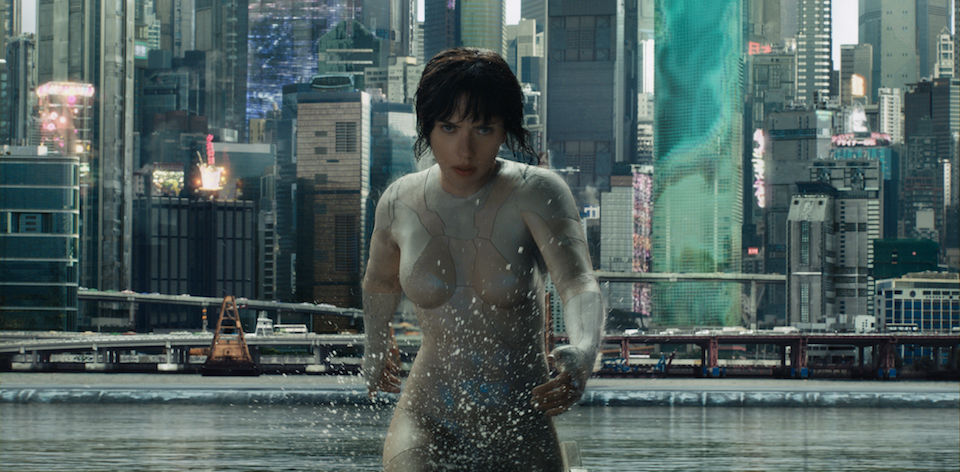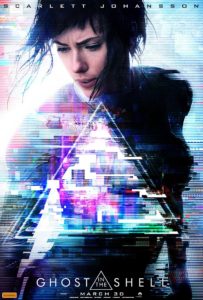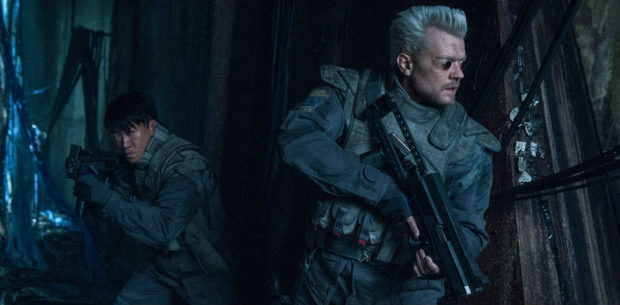Mamoru Oshii’s 1995 animated film Ghost in the Shell, itself based on the manga of the same name by Masamune Shirow, has become part of the anime canon over the last two decades. Praised for its stylish atmosphere and contemplative narrative about identity, it set the tone for many films that followed. Yet with Rupert Sanders’ remake, he keeps some of the shell intact but pulls apart the guts of the soul to leave us with a hollow husk.
After her consciousness is ‘rescued’ by Section 9, cyborg Major (Scarlett Johansson) and her partner Batou (Pilou Asbæk) are tasked with rooting out hackers and other criminals. When a new threat comes in the form of Kuze (Michael Pitt), Major finds everything she believes in to be false.
Borrowing some of the aesthetic of Ghost in the Shell 2: Innocence, along with selected plot points and wholesale scenes from of the 1995 original, GHOST IN THE SHELL is determined to latch itself on the appreciative parts of your eyeballs. Buildings are lit up with giant holographic advertisements, sort of like Blade Runner‘s skyline on crack, while figures and vehicles will be familiar to existing fans. Strangely, each of these is given copious exposition to justify their existence in the world, while other elements (such as an elongated origin story for Major) have only the most perfunctory flesh added. It’s all a delivery system for a memory of a film, as we get Sanders’ emotive translation rather than a true adaptation.
Johansson herself comes across as fairly rusty, as if she is remembering how to be human for most of the shoot. While the plethora of nudity in the original may be difficult to justify in a modern film, the fetishisation of technology combined with the shell-like costuming removes any humanity left, reducing her to nothing more than an object programmed to plod through the key scenes. In the climax of the film, Sanders’ literally tells us how he’s unapologetically shucked the original Motoko Kusanagi and placed her in Johansson’s shell. Takeshi Kitano’s hair and Asbæk’s eyes are also emblematic of this cold approach.
While GHOST IN THE SHELL could potentially stand happily by itself as a stylish modern action film, albeit one that’s thin on plotting with a one-dimensional villain, its name and legacy were never going to allow that. It’s not just Mamoru Oshii that it follows either, lifting visual cues from innumerable sci-fi films that have filled our screens in the intervening decades. Using recognition in place of real emotion, Sanders’ can only ever hope to be an approximation, which may be the closest he gets to understanding the politics of identity that underly Masamune Shirow’s story.
[stextbox id=”grey” bgcolor=”F2F2F2″ mleft=”5″ mright=”5″ image=”null”]2017 | US | DIR: Rupert Sanders | WRITER: Jamie Moss, William Wheeler, Ehren Kruger | CAST: Scarlett Johansson, Michael Pitt, Pilou Asbæk, Chin Han, Juliette Binoche | DISTRIBUTOR: Paramount (AUS) | RUNNING TIME: 106 minutes | RELEASE DATE: 30 March 2017 (AUS) [/stextbox]






